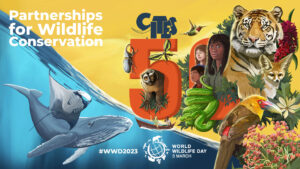GS3 – Environment
Con text
text
The year 2025 marks the 50th anniversary of the Convention on International Trade in Endangered Species of Wild Fauna and Flora (CITES), which came into force in 1975 as the world’s first legally binding agreement aimed at regulating international wildlife trade.
What is CITES?
CITES is a multilateral agreement that aims to ensure that global trade in wild animals and plants does not threaten their survival. Initially proposed at a 1963 IUCN meeting and signed in 1973 in Washington, D.C., it officially came into force in 1975.
The treaty is currently supported by 185 Parties, including nearly all United Nations member countries and the European Union. India ratified the treaty in 1976.
While CITES is legally binding, it does not supersede national legislation. Member states must implement its provisions through their domestic laws.
Scope and Objectives
- Prevent international trade from endangering the survival of wild species.
- Protect over 40,900 species of flora and fauna, including both live specimens and derivatives such as ivory, skins, timber, and roots.
- Monitor trade of terrestrial and aquatic species used for commercial, scientific, or other purposes.
Institutional Framework
- Operates under the United Nations Environment Programme (UNEP), with headquarters in Geneva.
- Implements a permit-based trade system grounded in scientific evaluation.
- Each member appoints:
- Management Authority – issues trade permits.
- Scientific Authority – provides species-specific guidance.
- Trade data is maintained in a global database managed by UNEP-WCMC.
- Conferences of the Parties (CoPs) are held every 2–3 years to review decisions and species listings.
CITES Appendices
- Appendix I: Species facing the highest risk of extinction; trade is strictly regulated and allowed only under exceptional conditions.
- Appendix II: Species not currently endangered but may become so; trade is controlled to avoid exploitation.
- Appendix III: Species protected in at least one country seeking international cooperation.
Key Initiatives and Programmes
- MIKE Programme: Tracks elephant poaching trends using field data from Asia and Africa.
- ICCWC: Facilitates enforcement by coordinating with agencies like INTERPOL, UNODC, and WCO.
- Tree Species Programme: Oversees sustainable trade of timber species such as mahogany and rosewood.
- Site-Based Monitoring: Links local surveillance systems to the CITES permit framework.
- Strategic Vision 2021–2030: Guides future goals in alignment with the Kunming–Montreal Global Biodiversity Framework.
India’s Role in CITES
- India acceded to CITES in 1976.
- The Additional Director General (Wildlife) of the Ministry of Environment, Forest and Climate Change serves as the designated Management Authority.
- The Wildlife Crime Control Bureau (WCCB) also functions as a permitting authority.
- India aligns its CITES commitments with the Kunming–Montreal Global Biodiversity Framework, which sets targets for halting biodiversity loss by 2030 and ensuring equitable benefit-sharing.
Major Achievements of CITES
- Global Governance Mechanism: Established the first standardized framework to manage wildlife trade internationally.
- Species Recovery: Trade regulations have helped restore populations of threatened species like the Nile crocodile.
- Permit Uniformity: Developed a consistent global system for species export/import regulation.
Enforcement Synergy: Through ICCWC, enhanced collaboration between customs, law enforcement, and conservation agencies.




